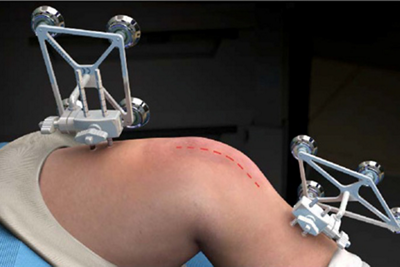Many studies worldwide have demonstrated positive key outcomes associated with robotic knee replacement surgery.


Dr Peter Smith, an Orthopaedic Surgeon operating from the Mediclinic Milnerton in Cape Town, Western Cape, shares the current benefits and expected outcomes of robotic knee replacement surgery using the Cori/Mako robotic systems.
We know that new treatments are being studied and developed for arthritis, meaning that, although there may not be a cure yet, the methods are improving the provision of long-term pain relief. Robotic-assisted surgery, one of these new methods, uses computer and robotic-aided technology to complement conventional surgical procedures.
During the conventional method for a knee replacement procedure, the damaged tissue in the knee is replaced with an artificial joint. A robotic knee replacement surgery is no different, but is performed with the assistance of a robotic arm or a handheld burr.
It is becoming more evident that robotic knee replacement surgery may offer faster relief, quicker recovery times and longer-lasting results. This is ground-breaking for patients suffering from severe knee pain caused by osteoarthritis.
According to Dr Smith, “A good candidate for traditional knee replacement surgery is equally a good candidate for robotic knee replacement. This is of course if your condition is severe enough to warrant surgery.” A doctor will usually recommend less invasive methods such as anti-inflammatory medications, weight loss through diet and exercise, cortisone injections, physical therapy or a knee brace.
“Joint replacement surgery is a big step to take, as artificial joints don’t last forever,” he explains, “However, new procedures like robotic knee replacement are making a difference to the longevity of these prosthesis. More accurate implant positioning means that even younger patients may be able to safely undergo total knee replacement surgery and get back to living an active lifestyle.”
While this relatively new procedure is assisted by a robotic arm or a handheld burr, your orthopaedic surgeon is still in control. The only job of the robotic arm or burr is to help the surgeon in planning and executing the surgical plan and greater precision in accurately positioning the implant.
4 key outcomes associated with robotic knee replacement surgery:
Potentially reduce recovery time
Although long term benefits haven’t been sufficiently studied, as these procedures are still fairly new, the short-term benefits, like the potential for reduced recovery time, are quickly becoming apparent. With a traditional total knee replacement, the average patient won’t be able to resume normal activities like driving and going to work until 4 to 6 weeks after surgery. Due to smaller incisions combined with greater surgical precision, robot-assisted technology could potentially cut the recovery time in half.
Improved accuracy allows customisation according to each patient
Because surgeons can customise knee replacements to each patient’s anatomy, some patients have reported a natural feeling after surgery. It is believed that this may be due to robotic techniques allowing for greater precision.
Know-how still matters
No state-of-the-art robotic instrument can replace the experience offered by a skilled orthopaedic surgeon, who has completed a high volume of surgeries with good outcomes. This is a robotic- assisted surgery and the end-result still comes down to technique and experience of the surgeon.
Robot assisted surgery comes with the same risks
Traditional knee surgery always carries the risk of nerve damage, deep vein thrombosis (blood clots), infection or an allergic reaction to the artificial joint. This is no different with robot-assisted surgery, however due to the smaller incision required and the greater accuracy with the robot’s assistance, could potentially be seeing these risks reduced.
Add to this the fact that for no specific reason, it has been shown in some studies that conventional knee replacements in 20% of cases are presenting with pain many years down the line, it would be a good idea to speak to your doctor about the new robot assisted surgery option.
“To sum it up, with the potential of a shorter hospital stay, improved kinematic alignment, better post-op function we should be trusting that robot-assisted knee surgery is the new method of choice in performing knee replacement surgery,” concludes Dr Smith.
Dr Peter Smith not only offers patients the full spectrum of professional orthopaedic treatments, but specialises in total knee replacement, total hip replacement, sports injuries and the latest arthroscopic surgery techniques and computer guided surgery. He gained extensive experience in the latest arthroplasty techniques during his stay of 6 years in Australia.


Disclaimer: The information provided in this article was correct at the time of publishing. At Mediclinic we endeavour to provide our patients and readers with accurate and reliable information, which is why we continually review and update our content. However, due to the dynamic nature of clinical information and medicine, some information may from time to time become outdated prior to revision.
Further publications on the topic
Doctors 1
?_ck=1616245880202)

